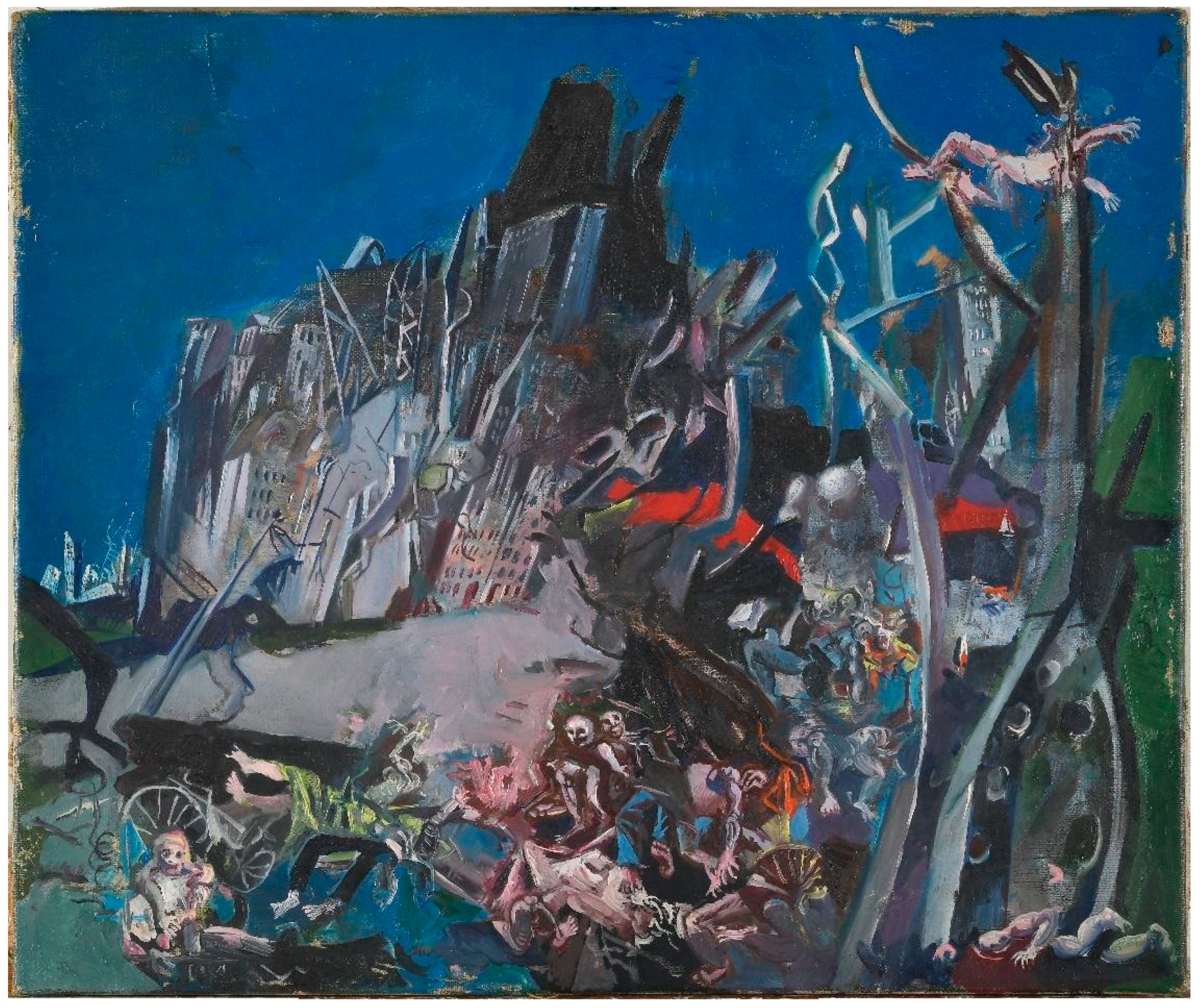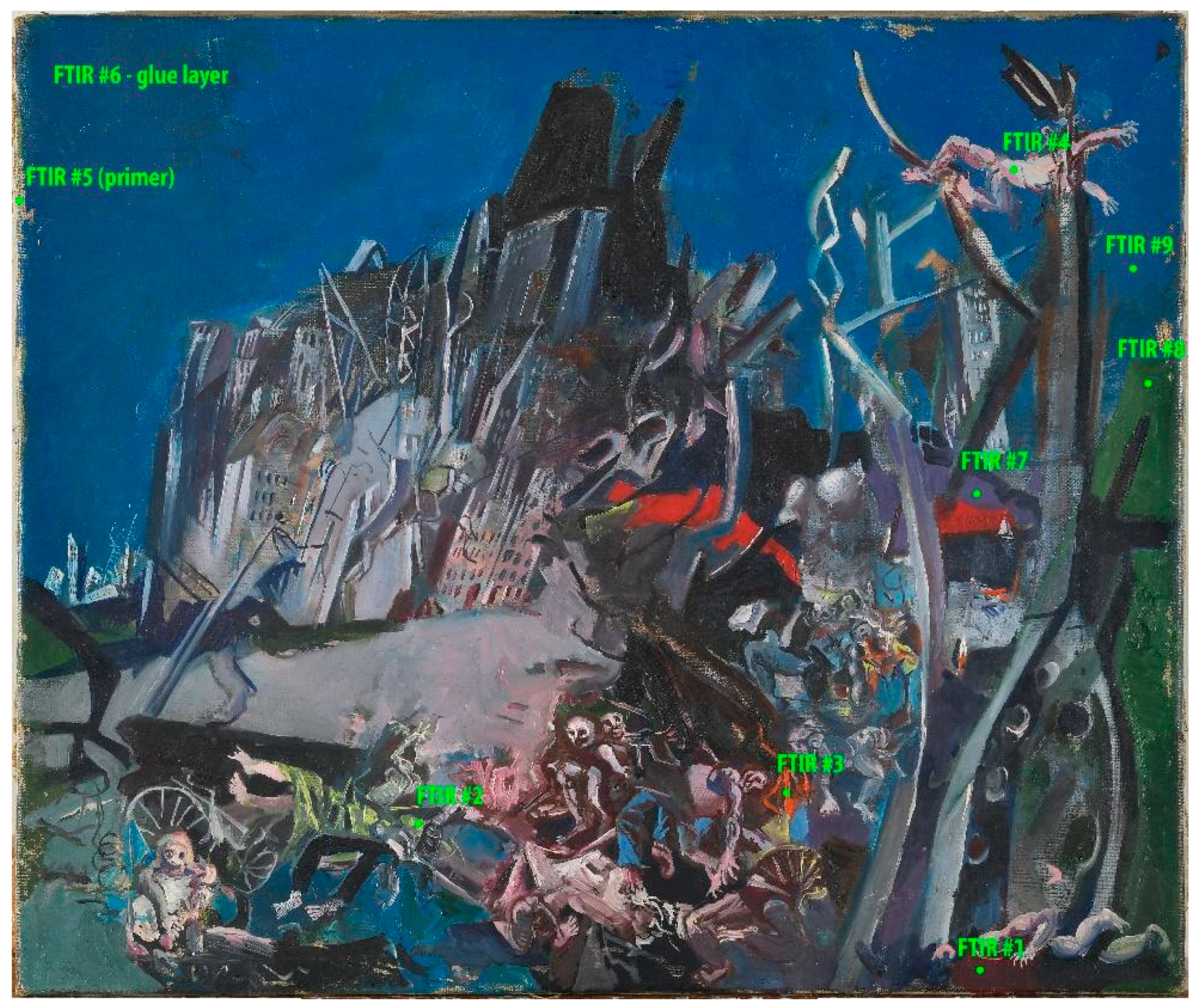In Situ Study of the Painting “Hiroshima I” (1958) by Werner Tübke (1929–2004)
Abstract
:Highlights
- A hidden portrait of Werner Tübke’s father was revealed.
- The state of the painting, the texture of the author’s brushstroke, the technique of applying the paint layer, the artist’s work on the composition, and the types of pigments and binders used were identified.
- The unique artistic language of Werner Tübke at an early stage of the artist’s work was examined.
- The grounds have been laid for the further comparison of Tübke’s early paintings with his later works, as well as his contemporaries’ and predecessors’.
Abstract
1. Introduction
2. Materials and Methods
2.1. Visual Analysis Methods
2.2. Qualitative Analysis Methods
3. Results
3.1. Preliminary Observations by Visual Analysis
3.2. Observations by UV Luminescence, IRR, Radiography
3.3. Elemental Analysis of Pictorial Layers (XRF)
3.4. FTIR-ATR Spectroscopy and Polarizing Microscopy
4. Discussion
5. Conclusions
Author Contributions
Funding
Acknowledgments
Conflicts of Interest
References
- Behrendt, H. Die Leipziger Malschule und Werner Tübke. Z. Kunstgesch. 2008, 71, 101–120. Available online: https://www.jstor.org/stable/40379326 (accessed on 21 January 2023).
- Eisman, A. Bernhard Heisig and the Fight for Modern Art in East Germany; Boydell and Brewer: Martlesham, UK; Camden House: London, UK, 2018; Available online: https://www.jstor.org/stable/j.ctv1qv129 (accessed on 21 January 2023).
- Makarinus, J. Über die Entfaltung der “Berliner Schule”. Forsch. Ber. 1991, 31, 313–328. Available online: https://www.jstor.org/stable/3881104 (accessed on 3 March 2023). [CrossRef]
- Tübke, W. Mein Herz Empfindet Optisch: Aus den Tagebüchern, Skizzen und Notizen; Michalski, A., Beaucamp, E., Eds.; Wallstein Verlag: Göttingen, Germany, 2017; p. 396. [Google Scholar]
- Osmond, J. German Modernism and Anti-Modernism. Burlingt. Mag. 1999, 141, 574–575. Available online: https://www.jstor.org/stable/888618 (accessed on 14 April 2023).
- Tübke, W. Gemalde, Aquarelle, Druckgrafik, Zeichnungen; Ministerium für Kultur DDR: Dresden, Germany; Leipzig, Germany; Berlin, Germany, 1976; 256p. [Google Scholar]
- Tübke, W. Das Malerische Werk: Verzeichnis der Gemälde 1976 bis 1999; Verlag der Kunst: Amsterdam, The Netherlands; Dresden, Germany, 1999; p. 299. [Google Scholar]
- Michalski, A.; Zöllner, F. Tübke-Schellenberger, Brigitte. Das “Grüne Skizzenbuch“ Werner Tübkes von 1952”; Plöttner: Leipzig, Germany, 2010. [Google Scholar]
- Michalski, A.; Zöllner, F. Tübke Stiftung Leipzig: Bestandskatalog der Gemälde; Plöttner: Leipzig, Germany, 2008; p. 90. [Google Scholar]
- Loest, E. Tübke-Bild im Fundus verwahren. J. Univ. Leipz. 2004, 6, 3. [Google Scholar]
- Meißner, G. Werner Tübke: Leben und Werke; Seemann: Leipzig, Germany, 1989; p. 400. [Google Scholar]
- Behrendt, H. Werner Tübkes Panoramabild in Bad Frankenhausen: Zwischen Staatlichem Prestigeprojekt und Künstlerischem Selbstauftrag; Bau + Kunst. Schleswig-Holsteinische Schriften zur Kunstgeschichte Series; Verlag Ludwig: Kiel, Germany, 2006; 424p. [Google Scholar]
- Gillen, E. “One can and should present an artistic vision of the end of the world”: Werner Tübke’s Apocalyptic Panorama in Bad Frankenhausen and the End of the German Democratic Republic. Getty Res. J. 2011, 3, 99–116. Available online: https://www.jstor.org/stable/23005390 (accessed on 23 April 2023). [CrossRef]
- Kober, K.M. Werner Tübke: Monumentalbild Frankenhausen; VEB Verlag der Kunst: Dresden, Germany, 1989; 104p. [Google Scholar]
- Beaucamp, E. Werner Tübke: Arbeiterklasse und Intelligenz. Eine Zeitgenössische Erprobung der Geschichte; Fisher: Frankfurt, Germany, 1985; 310p. [Google Scholar]
- Zöllner, F. Werner Tübke’s “History of the German Working Class Movement” of 1961 and its Place within his Comissioned Art Works. Artubus Hist. 2018, 39, 335–363. [Google Scholar]
- Von Poser, H.; Lohse, E.; Lindner, G.; Brade, J.; Kober, R. Der Zellerfelder Flügelaltar von Werner Tübke und seine Vorarbeiten; Panorama Museum: Bad Frankenhausen, Germany, 2007; 144p. [Google Scholar]
- Kober, R.; Lindner, G. Paradigma Grünewald: Zur Erbe-Rezeption in der bildenden Kunst der DDR. In Grünewald in der Moderne: Die Rezeption Matthias Grünewald im 20. Jahrhundert; Schad, B., Ratzka, T., Eds.; Wienand Verlag: Köln, Germany, 2003; pp. 32–43. [Google Scholar]
- The Ludwig Museum at the State Russian Museum; Palace Editions Europe: Saint Petersburg, Russia, 2009; Volume 225, 360p.
- Grenberg, U.I. Technology of Easel Painting: History and Research; Fine Arts: Moscow, Russia, 1982; pp. 308–318. [Google Scholar]
- Kiplik, D.I. Technique of Painting; Shevchuk, V., Ed.; Svarog i K: Moscow, Russia, 2011. [Google Scholar]
- Feinberg, L.E.; Grenberg, U.I. Secrets of Old Masters’ Painting; Fine Art: Moscow, Russia, 1989; 319p. [Google Scholar]
- Cosentino, A. Infrared Technical Photography for Art Examination. e-PreservationScience 2016, 13, 1–6. Available online: https://chsopensource.org/infrared-technical-photography-for-art-examination/ (accessed on 23 February 2023).
- Haddad, A.; Hartman, D.; Martins, A. Complex Relationships: A Materials Study of Édouard Vuillard’s Interior, Mother and Sister of the Artist. Heritage 2021, 4, 162. [Google Scholar] [CrossRef]
- Manzano, E.; Blanc, R.; Martin-Ramos, J.D.; Chiari, G.; Sarrazin, P.; Luis Vilchez, J. A combination of invasive and non-invasive techniques for the study of the palette and painting structure of a copy of Raphael’s Transfiguration of Christ. Herit. Sci. 2021, 9, 150. [Google Scholar] [CrossRef]
- De Meyer, S.; Vanmeert, F.; Vertongen, R.; Van Loon, A.; Gonzalez, V.; Delaney, J.; Dooley, K.; Dik, J.; Van der Snickt, G.; Vandivere, A.; et al. Macroscopic X-ray powder diffraction imaging reveals Vermeer’s discriminating use of lead white pigments in Girl with a Pearl Earring. Sci. Adv. 2019, 5, eaax1975. [Google Scholar] [CrossRef] [PubMed] [Green Version]
- Janssens, K.; Van der Snickt, G.; Vanmeert, F.; Legrand, S.; Nuyts, G.; Alfeld, M.; Monico, L.; Anaf, W.; De Nolf, W.; Vermeulen, M.; et al. Non-Invasive and Non-Destructive Examination of Artistic Pigments, Paints, and Paintings by Means of X-ray Methods. Top. Curr. Chem. 2016, 374, 81. [Google Scholar] [CrossRef] [PubMed] [Green Version]
- Turner, N.K.; Patterson, C.S.; MacLennan, D.K.; Trentelman, K. Visualizing underdrawings in medieval manuscript illuminations with macro-X-ray fluorescence scanning. X-Ray Spectrom. 2018, 48, 251–261. [Google Scholar] [CrossRef]
- Bonizzoni, L. ED-XRF analysis for Cultural Heritage: Is quantitative evaluation always essential? J. Phys. Conf. Ser. 2015, 630, 012001. [Google Scholar] [CrossRef] [Green Version]
- Calza, C.; Oliveira, D.F.; Freitas, R.P.; Rocha, H.S.; Nascimento, J.S.; Lopes, R.T. Analysis of sculptures using XRF and X-ray radiography. Radiat. Phys. Chem. 2015, 116, 326–331. [Google Scholar] [CrossRef]
- Giorgi, L.; Nevin, A.; Comelli, D.; Frizzi, T.; Alberti, R.; Zendri, E.; Piccolo, M.; Izzo, F.C. In-situ technical study of modern paintings—Part 2: Imaging and spectroscopic analysis of zinc white in paintings from 1889 to 1940 by Alessandro Milesi (1856–1945). Spectrochim. Acta Part A Mol. Biomol. Spectrosc. 2019, 219, 504–508. [Google Scholar] [CrossRef] [PubMed]
- Saverwyns, S.; Currie, C.; Lamas-Delgado, E. Macro X-ray fluorescence scanning (MA-XRF) as tool in the authentication of paintings. Microchem. J. 2018, 137, 139–147. [Google Scholar] [CrossRef]
- Khoury, H.N. Importance of Clay Minerals in Jordan Case Study: Volkonskoite as a Sink for Hazardous Elements of a High pH Plume. Jordan J. Earth Environ. Sci. JJEES 2014, 6, 1–10. Available online: https://www.researchgate.net/publication/278686077_Journal_Volk_Hani_Vol6SP3_HQ_P1-10 (accessed on 9 March 2023).
- Rosi, F.; Burnstock, A.; Van den Berg, K.J.; Miliani, C.; Brunetti, B.G.; Sgamellotti, A. A non-invasive XRF study supported by multivariate statistical analysis and reflectance FTIR to assess the composition of modern painting materials. Spectrochim. Acta Part A 2009, 71, 1655–1662. [Google Scholar] [CrossRef]
- Legan, L.; Retko, K.; Ropret, P. Vibrational spectroscopic study on degradation of alizarin carmine. Microchem. J. 2016, 127, 36–45. [Google Scholar] [CrossRef]
- Vila, A.; García, J.F. Analysis of the Chemical Composition of Red Pigments and Inks for the Characterization and Differentiation of Contemporary Prints. Anal. Lett. 2012, 45, 1274–1285. [Google Scholar] [CrossRef]
- Russell, J.; Singer, B.W.; Perry, J.J.; Bacon, A. The identification of synthetic organic pigments in modern paints and modern paintings using pyrolysis-gas chromatography–mass spectrometry. Anal. Bioanal. Chem. 2011, 400, 1473–1491. [Google Scholar] [CrossRef] [PubMed]
- Sundberg, B.N.; Pause, R.; van der Werf, I.D.; Astefanei, A.; van den Berg, K.J.; van Bommel, M.R. Analytical approaches for the characterization of early synthetic organic pigments for artists’ paints. Microchem. J. 2021, 170, 106708. [Google Scholar] [CrossRef]
- Van der Weerd, J.; Van Loon, A.; Boon, J.J. FTIR studies of the effects of pigments on the aging of oil. Stud. Conserv. 2005, 50, 3–22. [Google Scholar] [CrossRef]
- Catalli, K.; Santillan, J.; Williams, Q. A high pressure infrared spectroscopic study of PbCO3-cerussite: Constraints on the structure of the post-aragonite phase. Phys. Chem. Miner. 2005, 32, 412–417. [Google Scholar] [CrossRef]
- Osmond, G. Zinc Soaps: An Overview of Zinc Oxide Reactivity and Consequences of Soap Formation in Oil-Based Paintings. In Metal Soaps in Art; Springer: Cham, Switzerland, 2015; pp. 25–46. [Google Scholar] [CrossRef]
- Garrappa, S.; Kočía, E.; Švarcováa, S.; Bezdičkaa, P.; Hradila, D. Initial stages of metal soaps` formation in model paints: The role of humidity. Microchem. J. 2020, 156, 104842. [Google Scholar] [CrossRef]
- Linder, G. Werner Tübke: Handzeichnungen und Aquarelle; Seemann: Leipzig, Germany, 1992; p. 65. [Google Scholar]
- Menu, M.; Ezrati, J.J.; Laval, É.; Pagès, S.; Pricipaud, A.; Rioux, J.P.; Waiter, P.; Welcomme, É.; Nowik, W. Analyse de la palette des couleurs du Retable d’Issenheim par Matthias Grünewald. In La Technique Picturale de Grünewald et de ses Contemporains; Béguerie-De Paepe, P., Menu, M., Eds.; Musée d’Unterlinden: Colmar, France; Centre de Recherche et de Restauration des Musées de France: Paris, France, 2006. [Google Scholar]
- Fontoura, P.; Menu, M. Visual perception of natural colours in paintings: An eye-tracking study of Grünewald’s Resurrection. Color Res. Appl. 2021, 46, 582–594. [Google Scholar] [CrossRef]
- Lewer, D. Review: After Fascism: Two Views of Two Germanys. Oxf. Art J. 2009, 32, 466–471. Available online: https://www.jstor.org/stable/25650883 (accessed on 5 May 2023). [CrossRef]












| Spot# | Colour | Main Elements |
|---|---|---|
| 1 | White | Pb, Zn |
| 2 | Blue | Pb, Zn, Fe |
| 3 | Green | Pb, Zn, Cr, Fe |
| 4 | Violet | Pb, Zn, Fe |
| 5 | Red | Pb, Zn, Cd, Se, Ba, Hg |
| 6 | Brown | Fe |
| 7 | Scarlet | Pb, Zn |
| 8 | Yellow | Pb, Zn, Cd, Ba |
| 9 | Primer | Ca, Zn, Pb |
| Colour | Identified Pigments | XRF Spot# | FTIR Spot# |
|---|---|---|---|
| White | Lead white, zinc white | 1 | 4 |
| Blue | Ultramarine blue | 2 | 9 |
| Green | Cr containing compound | 3 | 8 |
| Violet | Fe containing compound | 4 | 7 |
| Red | Cd, Se, Hg containing compound, PR81 | 5 | 1 |
| Brown | Fe containing compound | 6 | - |
| Scarlet | PR3 | 7 | 3 |
| Yellow | Cd containing compound, PY3 | 8 | 2 |
| Primer | Lead white, zinc white, calcium carbonate | 9 | 5 |
Disclaimer/Publisher’s Note: The statements, opinions and data contained in all publications are solely those of the individual author(s) and contributor(s) and not of MDPI and/or the editor(s). MDPI and/or the editor(s) disclaim responsibility for any injury to people or property resulting from any ideas, methods, instructions or products referred to in the content. |
© 2023 by the authors. Licensee MDPI, Basel, Switzerland. This article is an open access article distributed under the terms and conditions of the Creative Commons Attribution (CC BY) license (https://creativecommons.org/licenses/by/4.0/).
Share and Cite
Smolianskaia, A.A.; Andreev, I.I.; Sirro, S.V.; Aseev, V.A.; Tereschenko, E.Y.; Smolyanskaya, O.A. In Situ Study of the Painting “Hiroshima I” (1958) by Werner Tübke (1929–2004). Heritage 2023, 6, 4802-4816. https://doi.org/10.3390/heritage6060255
Smolianskaia AA, Andreev II, Sirro SV, Aseev VA, Tereschenko EY, Smolyanskaya OA. In Situ Study of the Painting “Hiroshima I” (1958) by Werner Tübke (1929–2004). Heritage. 2023; 6(6):4802-4816. https://doi.org/10.3390/heritage6060255
Chicago/Turabian StyleSmolianskaia, Aleksandra A., Ivan I. Andreev, Sergey V. Sirro, Vladimir A. Aseev, Elena Y. Tereschenko, and Olga A. Smolyanskaya. 2023. "In Situ Study of the Painting “Hiroshima I” (1958) by Werner Tübke (1929–2004)" Heritage 6, no. 6: 4802-4816. https://doi.org/10.3390/heritage6060255
APA StyleSmolianskaia, A. A., Andreev, I. I., Sirro, S. V., Aseev, V. A., Tereschenko, E. Y., & Smolyanskaya, O. A. (2023). In Situ Study of the Painting “Hiroshima I” (1958) by Werner Tübke (1929–2004). Heritage, 6(6), 4802-4816. https://doi.org/10.3390/heritage6060255







